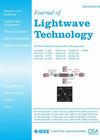用于载波提取自相干检测的超窄带宽硅光子可调谐CROW滤波器
IF 4.8
1区 工程技术
Q2 ENGINEERING, ELECTRICAL & ELECTRONIC
引用次数: 0
摘要
数据中心和5G前传网络对高容量短距离光互连的需求不断增长,对频谱效率、占地面积和功耗提出了严格的要求。在这些应用中,硅光子(SiP)自相干检测成为一种有吸引力的解决方案。微环谐振器(MRR)作为一种先进的SiP器件,由于其设计灵活性和波长选择性,在自相干检测系统等光通信系统中的应用潜力越来越大。在这项工作中,我们展示了一种基于二阶加降微环谐振器的硅光子可调谐超窄带宽(UNB)耦合谐振器光波导(CROW)滤波器。在最小插入损耗条件下,优化耦合系数,实现低插入损耗的UNB CROW滤波器。值得注意的是,CROW滤波器的3db带宽为1.26 ghz, 20db带宽为4.62 ghz,插入损耗约为4 db,消光比为60 db,该滤波器采用1 μm宽的脊波导,其侧壁散射较条形波导弱。由于其超窄带宽和高ER,可以为自相干信号提供良好的信号分量抑制,从而可以在不附加本振(LO)的情况下提取纯光载波实现相干检测。应用于载波提取自相干(CESC)检测系统,在100 km标准单模光纤(SSMF)上实现了168.3 Gb/s的传输速率,验证了该滤波器的性能。本文章由计算机程序翻译,如有差异,请以英文原文为准。
Silicon Photonic Tunable CROW Filter With Ultra-Narrow Bandwidth for Carrier-Extracted Self-Coherent Detection
The growing demand for high-capacity short-reach optical interconnects in datacenters and 5G fronthaul networks imposes stringent requirements on spectral efficiency, footprint and power consumption. In such applications, silicon photonic (SiP) self-coherent detection emerges as an attractive solution. As an advanced SiP device, microring resonator (MRR) also gains a significant attention due to its design flexibility and wavelength selectivity, heightening its application potential in optical communication systems such as self-coherent detection systems. In this work, we demonstrate a silicon photonic tunable ultra-narrow-bandwidth (UNB) coupled resonator optical waveguide (CROW) filer based on second-order add-drop microring resonators. Under the minimal insertion loss condition for the drop port, we optimize the coupling coefficients to achieve an UNB CROW filter with a low insertion loss. Significantly, the CROW filter has been demonstrated with a 1.26-GHz 3-dB bandwidth, 4.62-GHz 20-dB bandwidth, approximately 4-dB insertion loss and 60-dB extinction ratio (ER) based on a 1-μm-wide ridge waveguide which has a weaker sidewall scattering compared with a strip waveguide. Due to its ultra-narrow bandwidth and high ER, it can provide a good rejection of signal components for a self-coherent signal, thereby a pure optical carrier can be extracted to realize coherent detection without an additional local oscillator (LO). Applied in the carrier-extracted self-coherent (CESC) detection system, achieving a 168.3 Gb/s transmission rate over 100-km standard single mode fiber (SSMF), the performance of this CROW filter is well verified.
求助全文
通过发布文献求助,成功后即可免费获取论文全文。
去求助
来源期刊

Journal of Lightwave Technology
工程技术-工程:电子与电气
CiteScore
9.40
自引率
14.90%
发文量
936
审稿时长
3.9 months
期刊介绍:
The Journal of Lightwave Technology is comprised of original contributions, both regular papers and letters, covering work in all aspects of optical guided-wave science, technology, and engineering. Manuscripts are solicited which report original theoretical and/or experimental results which advance the technological base of guided-wave technology. Tutorial and review papers are by invitation only. Topics of interest include the following: fiber and cable technologies, active and passive guided-wave componentry (light sources, detectors, repeaters, switches, fiber sensors, etc.); integrated optics and optoelectronics; and systems, subsystems, new applications and unique field trials. System oriented manuscripts should be concerned with systems which perform a function not previously available, out-perform previously established systems, or represent enhancements in the state of the art in general.
 求助内容:
求助内容: 应助结果提醒方式:
应助结果提醒方式:


